Abstract
Alzheimer disease (AD) is a clinicopathologic syndrome of unknown etiology with numerous abnormalities in neuronal and nonneuronal cells. A review of the literature suggests that a common basic intracellular defect may underlie many of the reported abnormalities. We hypothesize impairment of the microtubule (MT) system as one explanation for the pathogenesis of AD. Evidence in support of the hypothesis includes the following: MTs are ubiquitous and vital cell components, unequally distributed, with the highest concentration in the brain; various abnormalities, including the key neuropathologic lesions, can be explained by impairments of the MT system; and experiments utilizing pharmacologic agents known to disrupt MTs have reproduced certain abnormalities observed in AD. The hypothesis provides a framework for systematic investigations of MTs at the cellular and molecular levels as well as the basis for in vivo diagnostic tests for AD.
Full text
PDF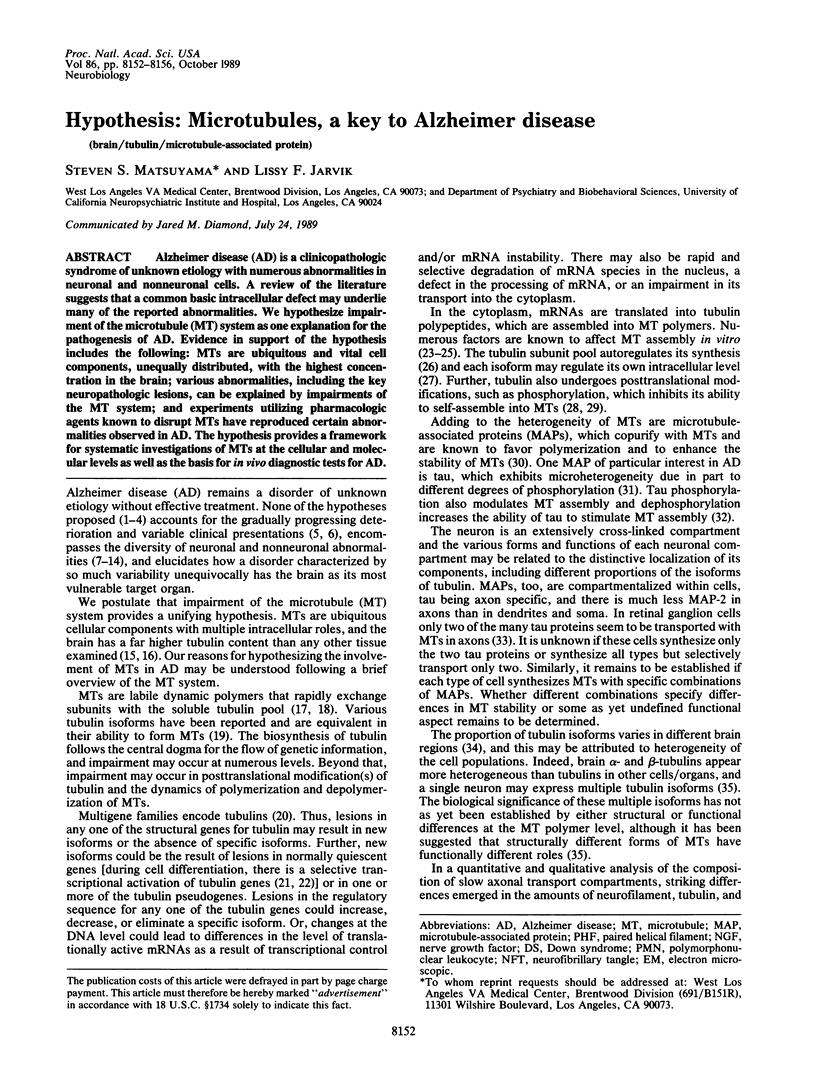
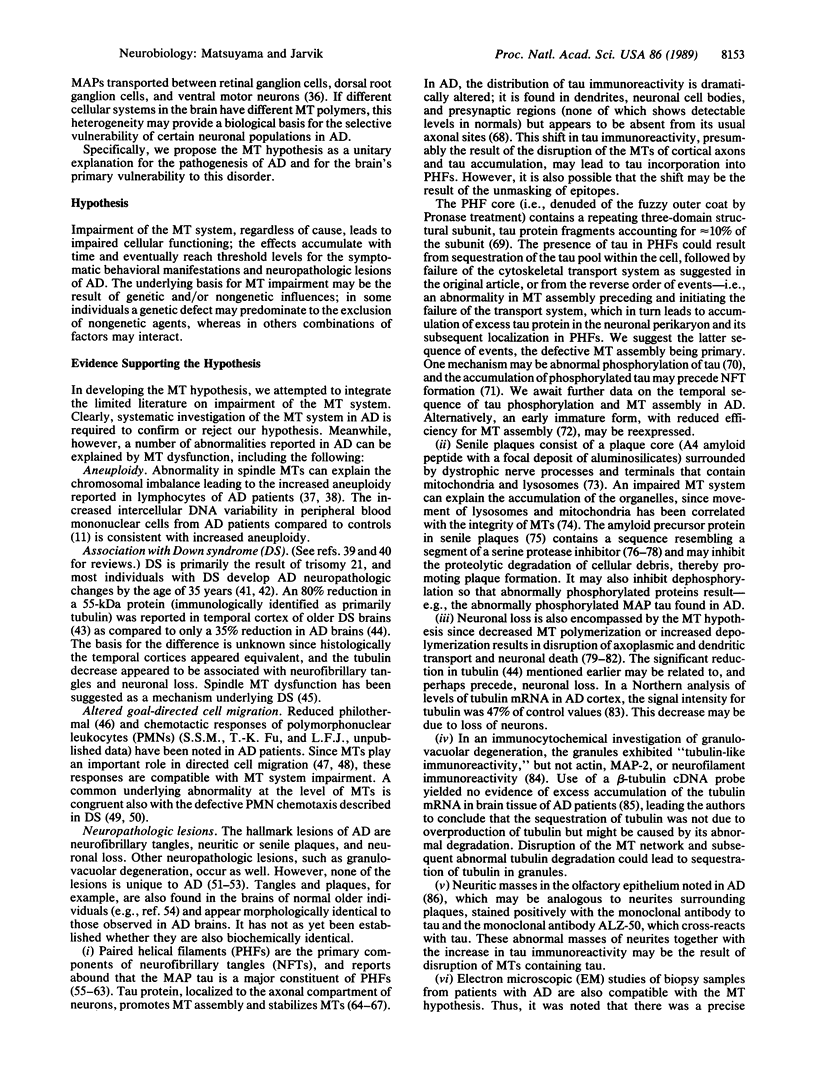
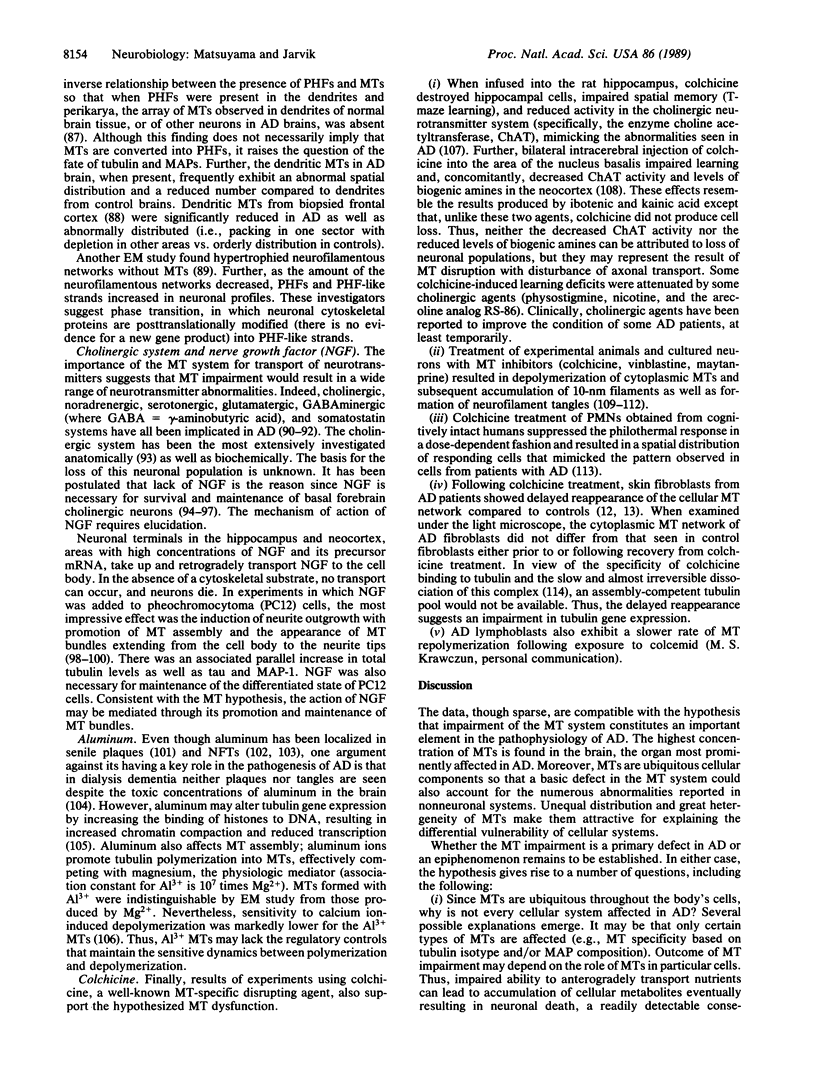
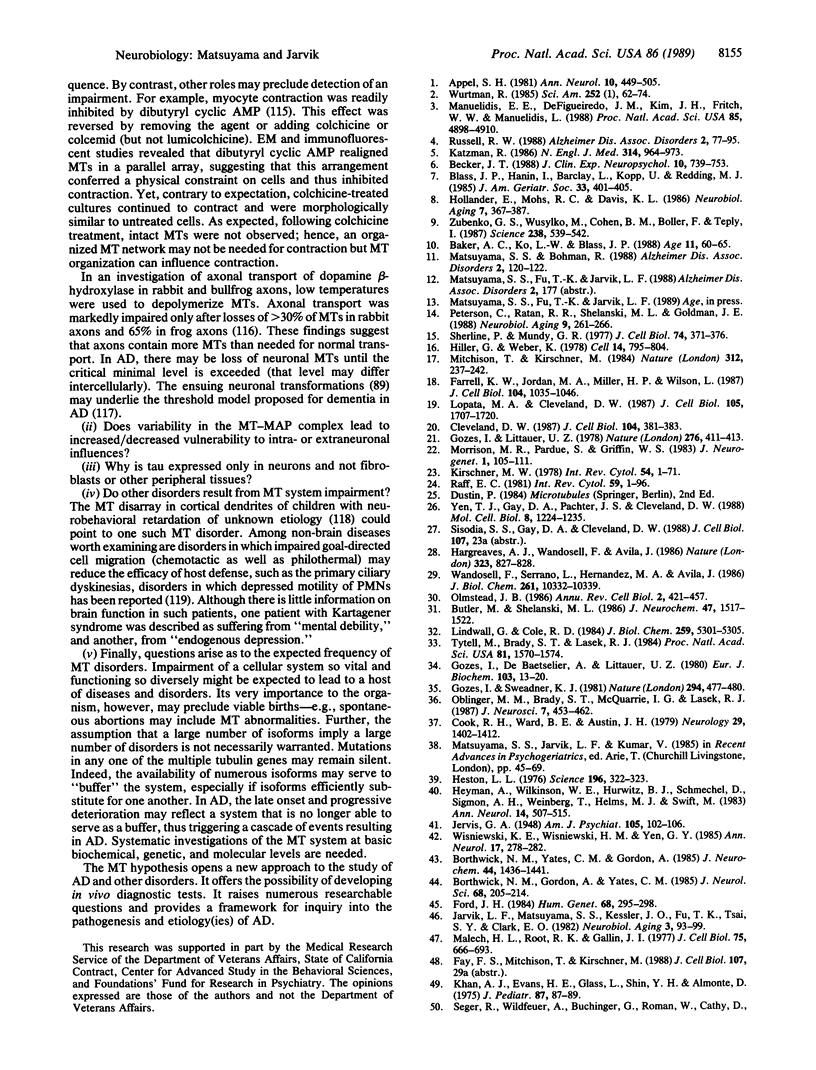
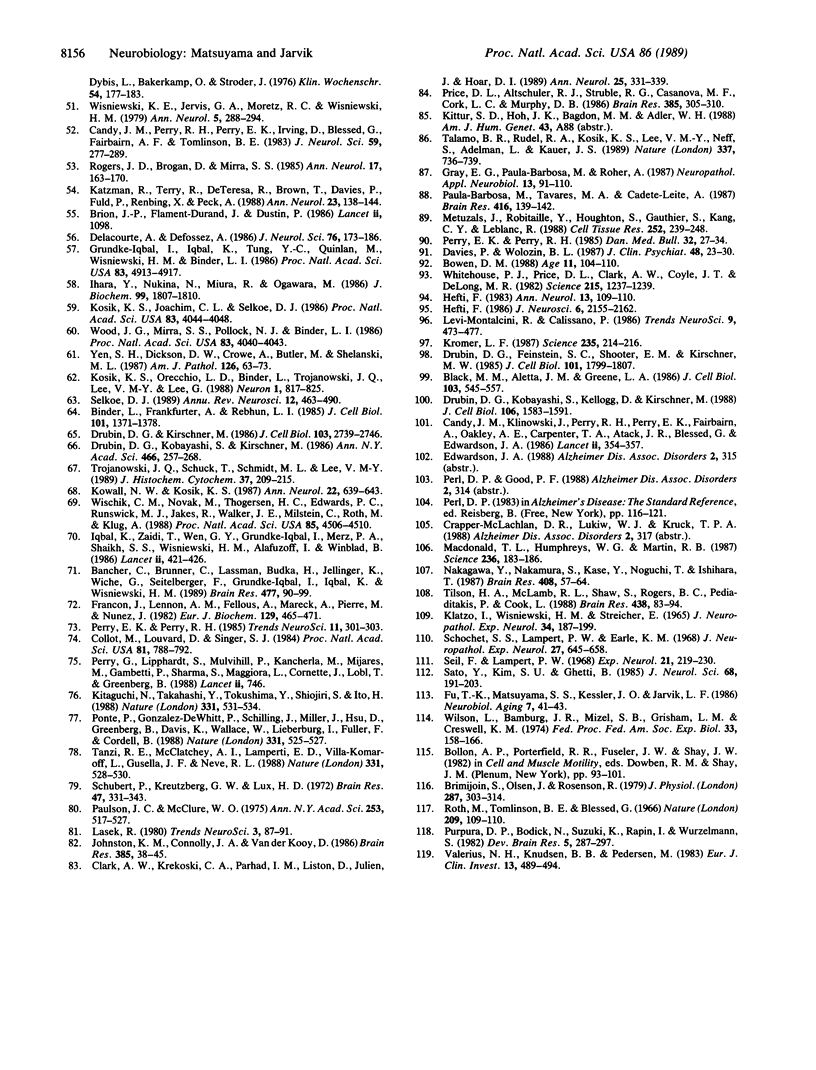
Selected References
These references are in PubMed. This may not be the complete list of references from this article.
- Appel S. H. A unifying hypothesis for the cause of amyotrophic lateral sclerosis, parkinsonism, and Alzheimer disease. Ann Neurol. 1981 Dec;10(6):499–505. doi: 10.1002/ana.410100602. [DOI] [PubMed] [Google Scholar]
- Bancher C., Brunner C., Lassmann H., Budka H., Jellinger K., Wiche G., Seitelberger F., Grundke-Iqbal I., Iqbal K., Wisniewski H. M. Accumulation of abnormally phosphorylated tau precedes the formation of neurofibrillary tangles in Alzheimer's disease. Brain Res. 1989 Jan 16;477(1-2):90–99. doi: 10.1016/0006-8993(89)91396-6. [DOI] [PubMed] [Google Scholar]
- Becker J. T. Working memory and secondary memory deficits in Alzheimer's disease. J Clin Exp Neuropsychol. 1988 Dec;10(6):739–753. doi: 10.1080/01688638808402811. [DOI] [PubMed] [Google Scholar]
- Binder L. I., Frankfurter A., Rebhun L. I. The distribution of tau in the mammalian central nervous system. J Cell Biol. 1985 Oct;101(4):1371–1378. doi: 10.1083/jcb.101.4.1371. [DOI] [PMC free article] [PubMed] [Google Scholar]
- Black M. M., Aletta J. M., Greene L. A. Regulation of microtubule composition and stability during nerve growth factor-promoted neurite outgrowth. J Cell Biol. 1986 Aug;103(2):545–557. doi: 10.1083/jcb.103.2.545. [DOI] [PMC free article] [PubMed] [Google Scholar]
- Blass J. P., Hanin I., Barclay L., Kopp U., Reding M. J. Red blood cell abnormalities in Alzheimer disease. J Am Geriatr Soc. 1985 Jun;33(6):401–405. doi: 10.1111/j.1532-5415.1985.tb07150.x. [DOI] [PubMed] [Google Scholar]
- Borthwick N. M., Gordon A., Yates C. M. Reductions in soluble brain proteins in older subjects with Down's syndrome. J Neurol Sci. 1985 May;68(2-3):205–214. doi: 10.1016/0022-510x(85)90101-7. [DOI] [PubMed] [Google Scholar]
- Borthwick N. M., Yates C. M., Gordon A. Reduced proteins in temporal cortex in Alzheimer's disease: an electrophoretic study. J Neurochem. 1985 May;44(5):1436–1441. doi: 10.1111/j.1471-4159.1985.tb08780.x. [DOI] [PubMed] [Google Scholar]
- Brimijoin S., Olsen J., Rosenson R. Comparison of the temperature-dependence of rapid axonal transport and microtubules in nerves of the rabbit and bullfrog. J Physiol. 1979 Feb;287:303–314. doi: 10.1113/jphysiol.1979.sp012660. [DOI] [PMC free article] [PubMed] [Google Scholar]
- Brion J. P., Flament-Durand J., Dustin P. Alzheimer's disease and tau proteins. Lancet. 1986 Nov 8;2(8515):1098–1098. doi: 10.1016/s0140-6736(86)90495-2. [DOI] [PubMed] [Google Scholar]
- Butler M., Shelanski M. L. Microheterogeneity of microtubule-associated tau proteins is due to differences in phosphorylation. J Neurochem. 1986 Nov;47(5):1517–1522. doi: 10.1111/j.1471-4159.1986.tb00788.x. [DOI] [PubMed] [Google Scholar]
- Candy J. M., Oakley A. E., Klinowski J., Carpenter T. A., Perry R. H., Atack J. R., Perry E. K., Blessed G., Fairbairn A., Edwardson J. A. Aluminosilicates and senile plaque formation in Alzheimer's disease. Lancet. 1986 Feb 15;1(8477):354–357. doi: 10.1016/s0140-6736(86)92319-6. [DOI] [PubMed] [Google Scholar]
- Candy J. M., Perry R. H., Perry E. K., Irving D., Blessed G., Fairbairn A. F., Tomlinson B. E. Pathological changes in the nucleus of Meynert in Alzheimer's and Parkinson's diseases. J Neurol Sci. 1983 May;59(2):277–289. doi: 10.1016/0022-510x(83)90045-x. [DOI] [PubMed] [Google Scholar]
- Clark A. W., Krekoski C. A., Parhad I. M., Liston D., Julien J. P., Hoar D. I. Altered expression of genes for amyloid and cytoskeletal proteins in Alzheimer cortex. Ann Neurol. 1989 Apr;25(4):331–339. doi: 10.1002/ana.410250404. [DOI] [PubMed] [Google Scholar]
- Cleveland D. W. The multitubulin hypothesis revisited: what have we learned? J Cell Biol. 1987 Mar;104(3):381–383. doi: 10.1083/jcb.104.3.381. [DOI] [PMC free article] [PubMed] [Google Scholar]
- Collot M., Louvard D., Singer S. J. Lysosomes are associated with microtubules and not with intermediate filaments in cultured fibroblasts. Proc Natl Acad Sci U S A. 1984 Feb;81(3):788–792. doi: 10.1073/pnas.81.3.788. [DOI] [PMC free article] [PubMed] [Google Scholar]
- Cook R. H., Ward B. E., Austin J. H. Studies in aging of the brain: IV. Familial Alzheimer disease: Relation to transmissible dementia, aneuploidy, and microtubular defects. Neurology. 1979 Oct;29(10):1402–1412. doi: 10.1212/wnl.29.10.1402. [DOI] [PubMed] [Google Scholar]
- Davies P., Wolozin B. L. Recent advances in the neurochemistry of Alzheimer's disease. J Clin Psychiatry. 1987 May;48 (Suppl):23–30. [PubMed] [Google Scholar]
- Delacourte A., Defossez A. Alzheimer's disease: Tau proteins, the promoting factors of microtubule assembly, are major components of paired helical filaments. J Neurol Sci. 1986 Dec;76(2-3):173–186. doi: 10.1016/0022-510x(86)90167-x. [DOI] [PubMed] [Google Scholar]
- Drubin D. G., Feinstein S. C., Shooter E. M., Kirschner M. W. Nerve growth factor-induced neurite outgrowth in PC12 cells involves the coordinate induction of microtubule assembly and assembly-promoting factors. J Cell Biol. 1985 Nov;101(5 Pt 1):1799–1807. doi: 10.1083/jcb.101.5.1799. [DOI] [PMC free article] [PubMed] [Google Scholar]
- Drubin D. G., Kirschner M. W. Tau protein function in living cells. J Cell Biol. 1986 Dec;103(6 Pt 2):2739–2746. doi: 10.1083/jcb.103.6.2739. [DOI] [PMC free article] [PubMed] [Google Scholar]
- Drubin D., Kobayashi S., Kellogg D., Kirschner M. Regulation of microtubule protein levels during cellular morphogenesis in nerve growth factor-treated PC12 cells. J Cell Biol. 1988 May;106(5):1583–1591. doi: 10.1083/jcb.106.5.1583. [DOI] [PMC free article] [PubMed] [Google Scholar]
- Drubin D., Kobayashi S., Kirschner M. Association of tau protein with microtubules in living cells. Ann N Y Acad Sci. 1986;466:257–268. doi: 10.1111/j.1749-6632.1986.tb38398.x. [DOI] [PubMed] [Google Scholar]
- Farrell K. W., Jordan M. A., Miller H. P., Wilson L. Phase dynamics at microtubule ends: the coexistence of microtubule length changes and treadmilling. J Cell Biol. 1987 Apr;104(4):1035–1046. doi: 10.1083/jcb.104.4.1035. [DOI] [PMC free article] [PubMed] [Google Scholar]
- Ford J. H. Spindle microtubular dysfunction in mothers of Down syndrome children. Hum Genet. 1984;68(4):295–298. doi: 10.1007/BF00292587. [DOI] [PubMed] [Google Scholar]
- Francon J., Lennon A. M., Fellous A., Mareck A., Pierre M., Nunez J. Heterogeneity of microtubule-associated proteins and brain development. Eur J Biochem. 1982 Dec 15;129(2):465–471. doi: 10.1111/j.1432-1033.1982.tb07072.x. [DOI] [PubMed] [Google Scholar]
- Fu T. K., Matsuyama S. S., Kessler J. O., Jarvik L. F. Philothermal response, microtubules and dementia. Neurobiol Aging. 1986 Jan-Feb;7(1):41–43. doi: 10.1016/0197-4580(86)90025-4. [DOI] [PubMed] [Google Scholar]
- Gozes I., Littauer U. Z. Tubulin microheterogeneity increases with rat brain maturation. Nature. 1978 Nov 23;276(5686):411–413. doi: 10.1038/276411a0. [DOI] [PubMed] [Google Scholar]
- Gozes I., Sweadner K. J. Multiple tubulin forms are expressed by a single neurone. Nature. 1981 Dec 3;294(5840):477–480. doi: 10.1038/294477a0. [DOI] [PubMed] [Google Scholar]
- Gozes I., de Baetselier A., Littauer U. Z. Translation in vitro of rat brain mRNA coding for a variety of tubulin forms. Eur J Biochem. 1980 Jan;103(1):13–20. doi: 10.1111/j.1432-1033.1980.tb04283.x. [DOI] [PubMed] [Google Scholar]
- Gray E. G., Paula-Barbosa M., Roher A. Alzheimer's disease: paired helical filaments and cytomembranes. Neuropathol Appl Neurobiol. 1987 Mar-Apr;13(2):91–110. doi: 10.1111/j.1365-2990.1987.tb00174.x. [DOI] [PubMed] [Google Scholar]
- Grundke-Iqbal I., Iqbal K., Tung Y. C., Quinlan M., Wisniewski H. M., Binder L. I. Abnormal phosphorylation of the microtubule-associated protein tau (tau) in Alzheimer cytoskeletal pathology. Proc Natl Acad Sci U S A. 1986 Jul;83(13):4913–4917. doi: 10.1073/pnas.83.13.4913. [DOI] [PMC free article] [PubMed] [Google Scholar]
- Hargreaves A. J., Wandosell F., Avila J. Phosphorylation of tubulin enhances its interaction with membranes. 1986 Oct 30-Nov 5Nature. 323(6091):827–828. doi: 10.1038/323827a0. [DOI] [PubMed] [Google Scholar]
- Hefti F. Is Alzheimer disease caused by lack of nerve growth factor? Ann Neurol. 1983 Jan;13(1):109–110. doi: 10.1002/ana.410130127. [DOI] [PubMed] [Google Scholar]
- Hefti F. Nerve growth factor promotes survival of septal cholinergic neurons after fimbrial transections. J Neurosci. 1986 Aug;6(8):2155–2162. doi: 10.1523/JNEUROSCI.06-08-02155.1986. [DOI] [PMC free article] [PubMed] [Google Scholar]
- Heston L. L. Alzheimer's disease, trisomy 21, and myeloproliferative disorders: associations suggesting a genetic diathesis. Science. 1977 Apr 15;196(4287):322–323. doi: 10.1126/science.196.4287.322. [DOI] [PubMed] [Google Scholar]
- Heyman A., Wilkinson W. E., Hurwitz B. J., Schmechel D., Sigmon A. H., Weinberg T., Helms M. J., Swift M. Alzheimer's disease: genetic aspects and associated clinical disorders. Ann Neurol. 1983 Nov;14(5):507–515. doi: 10.1002/ana.410140503. [DOI] [PubMed] [Google Scholar]
- Hiller G., Weber K. Radioimmunoassay for tubulin: a quantitative comparison of the tubulin content of different established tissue culture cells and tissues. Cell. 1978 Aug;14(4):795–804. doi: 10.1016/0092-8674(78)90335-5. [DOI] [PubMed] [Google Scholar]
- Hollander E., Mohs R. C., Davis K. L. Antemortem markers of Alzheimer's disease. Neurobiol Aging. 1986 Sep-Oct;7(5):367–407. doi: 10.1016/0197-4580(86)90164-8. [DOI] [PubMed] [Google Scholar]
- Ihara Y., Nukina N., Miura R., Ogawara M. Phosphorylated tau protein is integrated into paired helical filaments in Alzheimer's disease. J Biochem. 1986 Jun;99(6):1807–1810. doi: 10.1093/oxfordjournals.jbchem.a135662. [DOI] [PubMed] [Google Scholar]
- Iqbal K., Grundke-Iqbal I., Zaidi T., Merz P. A., Wen G. Y., Shaikh S. S., Wisniewski H. M., Alafuzoff I., Winblad B. Defective brain microtubule assembly in Alzheimer's disease. Lancet. 1986 Aug 23;2(8504):421–426. doi: 10.1016/s0140-6736(86)92134-3. [DOI] [PubMed] [Google Scholar]
- Jarvik L. F., Matsuyama S. S., Kessler J. O., Fu T. K., Tsai S. Y., Clark E. O. Philothermal response of polymorphonuclear leukocytes in dementia of the Alzheimer type. Neurobiol Aging. 1982 Summer;3(2):93–99. doi: 10.1016/0197-4580(82)90002-1. [DOI] [PubMed] [Google Scholar]
- Johnston K. M., Connolly J. A., van der Kooy D. Inhibition of axonal transport 'in vivo' by a tubulin-specific antibody. Brain Res. 1986 Oct 15;385(1):38–45. doi: 10.1016/0006-8993(86)91544-1. [DOI] [PubMed] [Google Scholar]
- KLATZO I., WISNIEWSKI H., STREICHER E. EXPERIMENTAL PRODUCTION OF NEUROFIBRILLARY DEGENERATION. I. LIGHT MICROSCOPIC OBSERVATIONS. J Neuropathol Exp Neurol. 1965 Apr;24:187–199. doi: 10.1097/00005072-196504000-00002. [DOI] [PubMed] [Google Scholar]
- Katzman R. Alzheimer's disease. N Engl J Med. 1986 Apr 10;314(15):964–973. doi: 10.1056/NEJM198604103141506. [DOI] [PubMed] [Google Scholar]
- Katzman R., Terry R., DeTeresa R., Brown T., Davies P., Fuld P., Renbing X., Peck A. Clinical, pathological, and neurochemical changes in dementia: a subgroup with preserved mental status and numerous neocortical plaques. Ann Neurol. 1988 Feb;23(2):138–144. doi: 10.1002/ana.410230206. [DOI] [PubMed] [Google Scholar]
- Khan A. J., Evans H. E., Glass L., Skin Y. H., Almonte D. Defective neutrophil chemotaxis in patients with Down syndrome. J Pediatr. 1975 Jul;87(1):87–89. doi: 10.1016/s0022-3476(75)80077-1. [DOI] [PubMed] [Google Scholar]
- Kirschner M. W. Microtubule assembly and nucleation. Int Rev Cytol. 1978;54:1–71. doi: 10.1016/s0074-7696(08)60164-3. [DOI] [PubMed] [Google Scholar]
- Kosik K. S., Joachim C. L., Selkoe D. J. Microtubule-associated protein tau (tau) is a major antigenic component of paired helical filaments in Alzheimer disease. Proc Natl Acad Sci U S A. 1986 Jun;83(11):4044–4048. doi: 10.1073/pnas.83.11.4044. [DOI] [PMC free article] [PubMed] [Google Scholar]
- Kosik K. S., Orecchio L. D., Binder L., Trojanowski J. Q., Lee V. M., Lee G. Epitopes that span the tau molecule are shared with paired helical filaments. Neuron. 1988 Nov;1(9):817–825. doi: 10.1016/0896-6273(88)90129-8. [DOI] [PubMed] [Google Scholar]
- Kowall N. W., Kosik K. S. Axonal disruption and aberrant localization of tau protein characterize the neuropil pathology of Alzheimer's disease. Ann Neurol. 1987 Nov;22(5):639–643. doi: 10.1002/ana.410220514. [DOI] [PubMed] [Google Scholar]
- Kromer L. F. Nerve growth factor treatment after brain injury prevents neuronal death. Science. 1987 Jan 9;235(4785):214–216. doi: 10.1126/science.3798108. [DOI] [PubMed] [Google Scholar]
- Lindwall G., Cole R. D. Phosphorylation affects the ability of tau protein to promote microtubule assembly. J Biol Chem. 1984 Apr 25;259(8):5301–5305. [PubMed] [Google Scholar]
- Lopata M. A., Cleveland D. W. In vivo microtubules are copolymers of available beta-tubulin isotypes: localization of each of six vertebrate beta-tubulin isotypes using polyclonal antibodies elicited by synthetic peptide antigens. J Cell Biol. 1987 Oct;105(4):1707–1720. doi: 10.1083/jcb.105.4.1707. [DOI] [PMC free article] [PubMed] [Google Scholar]
- Macdonald T. L., Humphreys W. G., Martin R. B. Promotion of tubulin assembly by aluminum ion in vitro. Science. 1987 Apr 10;236(4798):183–186. doi: 10.1126/science.3105058. [DOI] [PubMed] [Google Scholar]
- Malech H. L., Root R. K., Gallin J. I. Structural analysis of human neutrophil migration. Centriole, microtubule, and microfilament orientation and function during chemotaxis. J Cell Biol. 1977 Dec;75(3):666–693. doi: 10.1083/jcb.75.3.666. [DOI] [PMC free article] [PubMed] [Google Scholar]
- Manuelidis E. E., de Figueiredo J. M., Kim J. H., Fritch W. W., Manuelidis L. Transmission studies from blood of Alzheimer disease patients and healthy relatives. Proc Natl Acad Sci U S A. 1988 Jul;85(13):4898–4901. doi: 10.1073/pnas.85.13.4898. [DOI] [PMC free article] [PubMed] [Google Scholar]
- Matsuyama S. S., Bohman R. Variation in DNA content of mononuclear cells of patients with dementia of the Alzheimer type. Alzheimer Dis Assoc Disord. 1988;2(2):120–122. doi: 10.1097/00002093-198802020-00004. [DOI] [PubMed] [Google Scholar]
- Metuzals J., Robitaille Y., Houghton S., Gauthier S., Kang C. Y., Leblanc R. Neuronal transformations in Alzheimer's disease. Cell Tissue Res. 1988 May;252(2):239–248. doi: 10.1007/BF00214366. [DOI] [PubMed] [Google Scholar]
- Mitchison T., Kirschner M. Dynamic instability of microtubule growth. Nature. 1984 Nov 15;312(5991):237–242. doi: 10.1038/312237a0. [DOI] [PubMed] [Google Scholar]
- Morrison M. R., Pardue S., Griffin W. S. Altered expression of different tubulin electrophoretic variants during human cortex development. J Neurogenet. 1983 Sep;1(1):105–111. doi: 10.3109/01677068309107076. [DOI] [PubMed] [Google Scholar]
- Nakagawa Y., Nakamura S., Kaśe Y., Noguchi T., Ishihara T. Colchicine lesions in the rat hippocampus mimic the alterations of several markers in Alzheimer's disease. Brain Res. 1987 Apr 7;408(1-2):57–64. doi: 10.1016/0006-8993(87)90358-1. [DOI] [PubMed] [Google Scholar]
- Oblinger M. M., Brady S. T., McQuarrie I. G., Lasek R. J. Cytotypic differences in the protein composition of the axonally transported cytoskeleton in mammalian neurons. J Neurosci. 1987 Feb;7(2):453–462. doi: 10.1523/JNEUROSCI.07-02-00453.1987. [DOI] [PMC free article] [PubMed] [Google Scholar]
- Olmsted J. B. Microtubule-associated proteins. Annu Rev Cell Biol. 1986;2:421–457. doi: 10.1146/annurev.cb.02.110186.002225. [DOI] [PubMed] [Google Scholar]
- Paula-Barbosa M., Tavares M. A., Cadete-Leite A. A quantitative study of frontal cortex dendritic microtubules in patients with Alzheimer's disease. Brain Res. 1987 Aug 4;417(1):139–142. doi: 10.1016/0006-8993(87)90188-0. [DOI] [PubMed] [Google Scholar]
- Paulson J. C., McClure W. O. Inhibition of axoplasmic transport by colchicine, podophyllotoxin, and vinblastine: an effect on microtubules. Ann N Y Acad Sci. 1975 Jun 30;253:517–527. doi: 10.1111/j.1749-6632.1975.tb19225.x. [DOI] [PMC free article] [PubMed] [Google Scholar]
- Perry E. K., Perry R. H. A review of neuropathological and neurochemical correlates of Alzheimer's disease. Dan Med Bull. 1985 Feb;32 (Suppl 1):27–34. [PubMed] [Google Scholar]
- Perry G., Lipphardt S., Mulvihill P., Kancherla M., Mijares M., Gambetti P., Sharma S., Maggiora L., Cornette J., Lobl T. Amyloid precursor protein in senile plaques of Alzheimer disease. Lancet. 1988 Sep 24;2(8613):746–746. doi: 10.1016/s0140-6736(88)90219-x. [DOI] [PubMed] [Google Scholar]
- Peterson C., Ratan R. R., Shelanski M. L., Goldman J. E. Altered response of fibroblasts from aged and Alzheimer donors to drugs that elevate cytosolic free calcium. Neurobiol Aging. 1988 May-Jun;9(3):261–266. doi: 10.1016/s0197-4580(88)80063-0. [DOI] [PubMed] [Google Scholar]
- Ponte P., Gonzalez-DeWhitt P., Schilling J., Miller J., Hsu D., Greenberg B., Davis K., Wallace W., Lieberburg I., Fuller F. A new A4 amyloid mRNA contains a domain homologous to serine proteinase inhibitors. Nature. 1988 Feb 11;331(6156):525–527. doi: 10.1038/331525a0. [DOI] [PubMed] [Google Scholar]
- Price D. L., Altschuler R. J., Struble R. G., Casanova M. F., Cork L. C., Murphy D. B. Sequestration of tubulin in neurons in Alzheimer's disease. Brain Res. 1986 Oct 22;385(2):305–310. doi: 10.1016/0006-8993(86)91077-2. [DOI] [PubMed] [Google Scholar]
- Purpura D. P., Bodick N., Suzuki K., Rapin I., Wurzelmann S. Microtubule disarray in cortical dendrites and neurobehavioral failure. I. Golgi and electron microscopic studies. Brain Res. 1982 Nov;281(3):287–297. doi: 10.1016/0165-3806(82)90128-6. [DOI] [PubMed] [Google Scholar]
- Raff E. C. The control of microtubule assembly in vivo. Int Rev Cytol. 1979;59:1–96. doi: 10.1016/s0074-7696(08)61660-5. [DOI] [PubMed] [Google Scholar]
- Rogers J. D., Brogan D., Mirra S. S. The nucleus basalis of Meynert in neurological disease: a quantitative morphological study. Ann Neurol. 1985 Feb;17(2):163–170. doi: 10.1002/ana.410170210. [DOI] [PubMed] [Google Scholar]
- Roth M., Tomlinson B. E., Blessed G. Correlation between scores for dementia and counts of 'senile plaques' in cerebral grey matter of elderly subjects. Nature. 1966 Jan 1;209(5018):109–110. doi: 10.1038/209109a0. [DOI] [PubMed] [Google Scholar]
- Russell R. W. Brain "transplants", neurotrophic factors and behavior. Alzheimer Dis Assoc Disord. 1988;2(2):77–95. doi: 10.1097/00002093-198802020-00001. [DOI] [PubMed] [Google Scholar]
- Sato Y., Kim S. U., Ghetti B. Induction of neurofibrillary tangles in cultured mouse neurons by maytanprine. J Neurol Sci. 1985 May;68(2-3):191–203. doi: 10.1016/0022-510x(85)90100-5. [DOI] [PubMed] [Google Scholar]
- Schochet S. S., Jr, Lampert P. W., Earle K. M. Neuronal changes induced by intrathecal vincristine sulfate. J Neuropathol Exp Neurol. 1968 Oct;27(4):645–658. [PubMed] [Google Scholar]
- Schubert P., Kreutzberg G. W., Lux H. D. Neuroplasmic transport in dendrites: effect of colchicine on morphology and physiology of motoneurones in the cat. Brain Res. 1972 Dec 12;47(2):331–343. doi: 10.1016/0006-8993(72)90643-9. [DOI] [PubMed] [Google Scholar]
- Seger R., Wildfeuer A., Buchinger G., Romen W., Catty D., Dybas L., Haferkamp O., Ströder J. Defects in granulocyte function in various chromosome abnormalities (Down's-, Edwards'-, Cri-du-chat syndrome). Klin Wochenschr. 1976 Feb 15;54(4):177–183. doi: 10.1007/BF01468883. [DOI] [PubMed] [Google Scholar]
- Seil F. J. Neurofibrillary tangles induced by vincristine and vinblastine sulfate in central and peripheral neurons in vitro. Exp Neurol. 1968 Jun;21(2):219–230. doi: 10.1016/0014-4886(68)90140-4. [DOI] [PubMed] [Google Scholar]
- Selkoe D. J. Biochemistry of altered brain proteins in Alzheimer's disease. Annu Rev Neurosci. 1989;12:463–490. doi: 10.1146/annurev.ne.12.030189.002335. [DOI] [PubMed] [Google Scholar]
- Sherline P., Mundy G. R. Role of the tubulin-microtubule system in lymphocyte activation. J Cell Biol. 1977 Aug;74(2):371–376. doi: 10.1083/jcb.74.2.371. [DOI] [PMC free article] [PubMed] [Google Scholar]
- Talamo B. R., Rudel R., Kosik K. S., Lee V. M., Neff S., Adelman L., Kauer J. S. Pathological changes in olfactory neurons in patients with Alzheimer's disease. Nature. 1989 Feb 23;337(6209):736–739. doi: 10.1038/337736a0. [DOI] [PubMed] [Google Scholar]
- Tanzi R. E., McClatchey A. I., Lamperti E. D., Villa-Komaroff L., Gusella J. F., Neve R. L. Protease inhibitor domain encoded by an amyloid protein precursor mRNA associated with Alzheimer's disease. Nature. 1988 Feb 11;331(6156):528–530. doi: 10.1038/331528a0. [DOI] [PubMed] [Google Scholar]
- Tilson H. A., McLamb R. L., Shaw S., Rogers B. C., Pediaditakis P., Cook L. Radial-arm maze deficits produced by colchicine administered into the area of the nucleus basalis are ameliorated by cholinergic agents. Brain Res. 1988 Jan 12;438(1-2):83–94. doi: 10.1016/0006-8993(88)91326-1. [DOI] [PubMed] [Google Scholar]
- Trojanowski J. Q., Schuck T., Schmidt M. L., Lee V. M. Distribution of tau proteins in the normal human central and peripheral nervous system. J Histochem Cytochem. 1989 Feb;37(2):209–215. doi: 10.1177/37.2.2492045. [DOI] [PubMed] [Google Scholar]
- Tytell M., Brady S. T., Lasek R. J. Axonal transport of a subclass of tau proteins: evidence for the regional differentiation of microtubules in neurons. Proc Natl Acad Sci U S A. 1984 Mar;81(5):1570–1574. doi: 10.1073/pnas.81.5.1570. [DOI] [PMC free article] [PubMed] [Google Scholar]
- Valerius N. H., Knudsen B. B., Pedersen M. Defective neutrophil motility in patients with primary ciliary dyskinesia. Eur J Clin Invest. 1983 Dec;13(6):489–494. doi: 10.1111/j.1365-2362.1983.tb00134.x. [DOI] [PubMed] [Google Scholar]
- Wandosell F., Serrano L., Hernández M. A., Avila J. Phosphorylation of tubulin by a calmodulin-dependent protein kinase. J Biol Chem. 1986 Aug 5;261(22):10332–10339. [PubMed] [Google Scholar]
- Whitehouse P. J., Price D. L., Struble R. G., Clark A. W., Coyle J. T., Delon M. R. Alzheimer's disease and senile dementia: loss of neurons in the basal forebrain. Science. 1982 Mar 5;215(4537):1237–1239. doi: 10.1126/science.7058341. [DOI] [PubMed] [Google Scholar]
- Wilson L., Bamburg J. R., Mizel S. B., Grisham L. M., Creswell K. M. Interaction of drugs with microtubule proteins. Fed Proc. 1974 Feb;33(2):158–166. [PubMed] [Google Scholar]
- Wischik C. M., Novak M., Thøgersen H. C., Edwards P. C., Runswick M. J., Jakes R., Walker J. E., Milstein C., Roth M., Klug A. Isolation of a fragment of tau derived from the core of the paired helical filament of Alzheimer disease. Proc Natl Acad Sci U S A. 1988 Jun;85(12):4506–4510. doi: 10.1073/pnas.85.12.4506. [DOI] [PMC free article] [PubMed] [Google Scholar]
- Wisniewski K. E., Wisniewski H. M., Wen G. Y. Occurrence of neuropathological changes and dementia of Alzheimer's disease in Down's syndrome. Ann Neurol. 1985 Mar;17(3):278–282. doi: 10.1002/ana.410170310. [DOI] [PubMed] [Google Scholar]
- Wisniewski K., Jervis G. A., Moretz R. C., Wisniewski H. M. Alzheimer neurofibrillary tangles in diseases other than senile and presenile dementia. Ann Neurol. 1979 Mar;5(3):288–294. doi: 10.1002/ana.410050311. [DOI] [PubMed] [Google Scholar]
- Wood J. G., Mirra S. S., Pollock N. J., Binder L. I. Neurofibrillary tangles of Alzheimer disease share antigenic determinants with the axonal microtubule-associated protein tau (tau) Proc Natl Acad Sci U S A. 1986 Jun;83(11):4040–4043. doi: 10.1073/pnas.83.11.4040. [DOI] [PMC free article] [PubMed] [Google Scholar]
- Wurtman R. J. Alzheimer's disease. Sci Am. 1985 Jan;252(1):62-6, 71-4. doi: 10.1038/scientificamerican0185-62. [DOI] [PubMed] [Google Scholar]
- Yen T. J., Gay D. A., Pachter J. S., Cleveland D. W. Autoregulated changes in stability of polyribosome-bound beta-tubulin mRNAs are specified by the first 13 translated nucleotides. Mol Cell Biol. 1988 Mar;8(3):1224–1235. doi: 10.1128/mcb.8.3.1224. [DOI] [PMC free article] [PubMed] [Google Scholar]
- Zubenko G. S., Wusylko M., Cohen B. M., Boller F., Teply I. Family study of platelet membrane fluidity in Alzheimer's disease. Science. 1987 Oct 23;238(4826):539–542. doi: 10.1126/science.3659926. [DOI] [PubMed] [Google Scholar]


